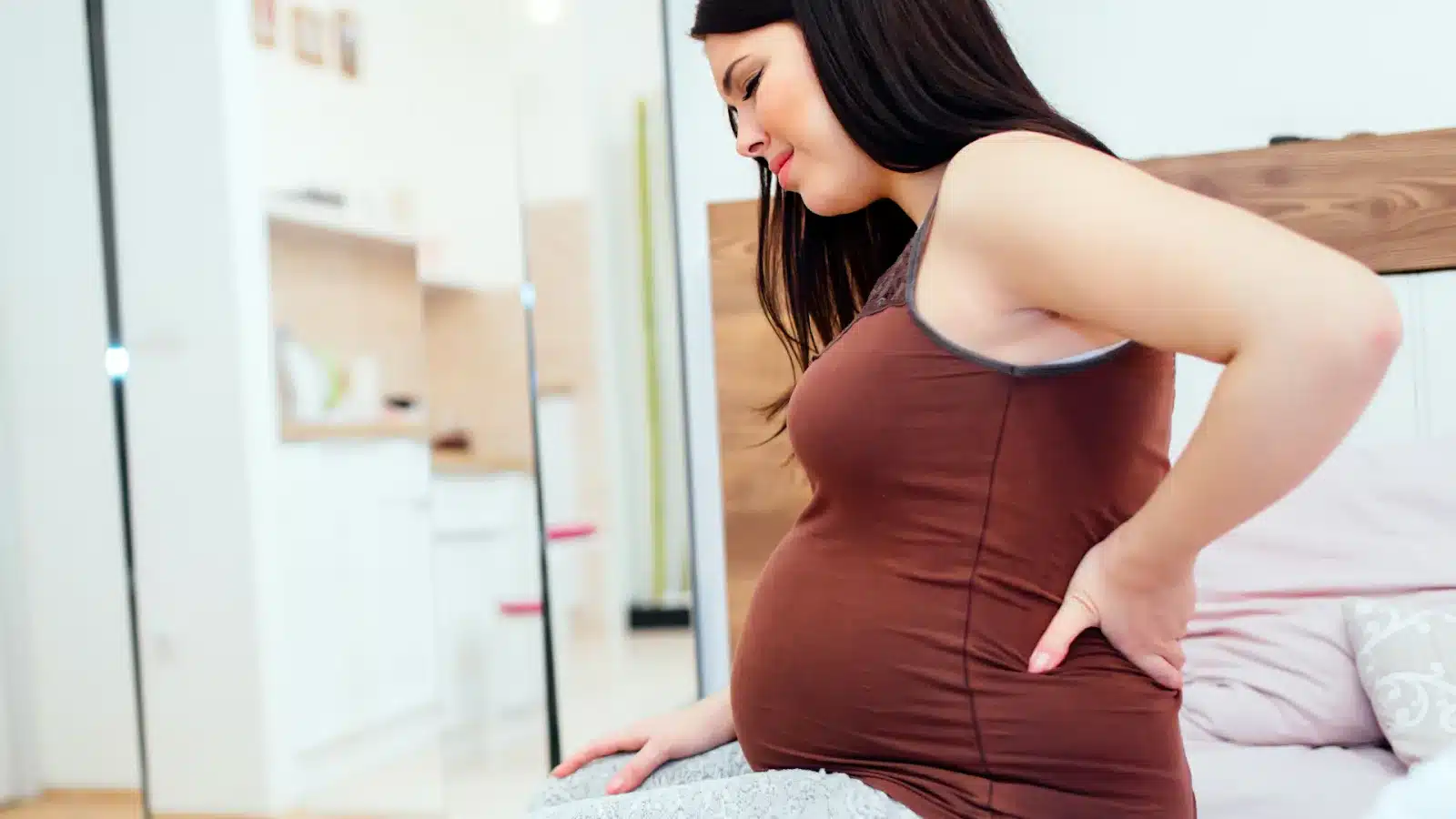Lower Back Pain During Pregnancy: Causes and Relief

Pregnancy is a beautiful journey, but it comes with its fair share of physical discomforts. For many mums, lower back pain is one of the most common struggles. It might show up after a long day on your feet or from simply sitting too long. You try stretching, adjusting, anything to find relief, yet that persistent ache keeps coming back.
If you’re going through this, know you’re not alone. In fact, more than 40% of pregnant women experience lower back pain, especially during the second and third trimesters. It’s a shared experience, one that’s completely normal. And while it can be tough, there are gentle ways to find relief and feel more supported as your body changes.
What You’ll Learn in This Guide:
- Common causes of lower back pain in each trimester
- Everyday habits that may worsen the discomfort
- Safe stretches and exercises to relieve back tension
- Supportive tools like maternity belts and pillows
- Signs it’s time to call your healthcare provider
Why You Might Be Feeling Lower Back Pain During Pregnancy
As your pregnancy progresses, your body is making space and adapting in remarkable ways. Naturally, that can bring some unexpected pressure and strain, especially on your lower back.
For many mums, this discomfort begins between weeks 20 and 28, though it can start earlier too. It might feel like a dull ache, a heavy pressure across your hips, or a steady soreness that builds throughout the day.
However it shows up, it’s real, it matters, and there are gentle ways to ease it.
What’s Behind the Ache? 5 Possible Reasons for Pregnancy Back Pain

Lower back pain often results from a combination of natural body changes and everyday movements. There is not always one big cause; sometimes, your body adjusts in ways that can feel uncomfortable.
Here are five common reasons your back might be feeling the strain:
- Hormonal changes (relaxin): During pregnancy, your body releases a hormone called relaxin, which softens your joints and ligaments to prepare for birth. While it’s completely natural, it can make your spine and pelvis feel less stable, which may lead to soreness.
- Your bump changes your posture: As your baby grows, your center of gravity shifts forward, affecting your posture. This often makes you lean back without even realizing it, putting more pressure on your lower spine and muscles.
- Your core’s working overtime: As your belly expands, your abdominal muscles stretch and weaken. That means your lower back has to pick up the slack, which can lead to extra tension and fatigue.
- Extra weight = extra strain: Gaining weight is a healthy part of pregnancy, but it naturally puts more pressure on your back, especially in the later months when you’re carrying more up front.
- Everyday habits add up: Simple things, such as sitting or standing for too long, bending without support, or wearing unsupportive shoes, can contribute to back pain over time.
Everyday Exercises to Support Your Back with Care

You don’t need intense workouts to feel better, just a few mindful movements can go a long way. According to the American College of Obstetricians and Gynecologists (ACOG), pregnancy-related weight gain and a shifting center of gravity increase stress on joints and the spine due to progressive lordosis (inward spinal curve).
To ease this strain, gentle stretches and pregnancy-safe exercises can help improve posture, reduce tension, and support your changing body. Here are some simple, bump-friendly ways to move with care:
1. Pelvic Tilts
If your lower back feels stiff or achy, gentle pelvic tilts might bring some relief. They’re safe, simple, and can be done standing against a wall or on your hands and knees, whatever feels right for your body. These soft, flowing movements help ease pressure on your spine while gently strengthening the muscles that support your core and lower back.
- Prenatal Yoga Poses
Even a few quiet moments on your mat can offer comfort when your back feels tense or tight. Gentle poses like Cat-Cow or Child’s Pose softly stretch your spine, release built-up tension, and create space where you might be feeling cramped. These yoga poses are also a great way to slow down, breathe deeply, and reconnect with your changing body.
- Walking
Walking is one of the simplest ways to stay active during pregnancy. Even a short stroll around the block can reduce stiffness in your lower back, improve circulation, and lift your mood. It doesn’t have to be long or fast, just consistent, gentle movement to keep you feeling a bit more like yourself.
- Swimming or Water Aerobics
Spending time in the water can feel incredibly soothing, taking the weight off your joints, including your spine and pelvis. Whether it’s a quiet swim or a gentle prenatal water class, the buoyancy helps you move with ease and comfort. It’s a wonderful option, especially in the later stages of pregnancy, when walking around can start to feel a little more difficult.
- Seated Forward Bends
If your back feels tense, a supported forward bend can help release that tightness and bring relief. You can sit on the edge of a cushion or folded blanket with your legs in front of you and gently fold forward, keeping your knees slightly bent. This stretch helps release tension in the lower back, providing a quiet moment to unwind.
- Gentle Hip Circles on a Birthing Ball
Some days, even sitting feels like a challenge, especially as your body stretches and shifts. A birthing ball can be a gentle companion. Sinking into its support and moving your hips in slow, soothing circles can ease lower back pressure, open your pelvis, and help your body feel more relaxed and supported.
Caring Adjustments to Ease Discomfort During Pregnancy

Gentle stretches, better posture, or simply pausing to rest can go a long way in easing lower back pain. A warm compress may also help relax tight muscles and bring soothing relief. Small comforts like these can make a real difference, one moment at a time.
Here are a few more supportive adjustments that can help you:
- Create a Back-Friendly Daily Routine
If you’ve been sitting for long stretches, whether working, resting, or commuting, it’s no surprise your lower back might start to ache. That stiffness is your body’s way of asking for a little movement. Try standing up every hour to stretch, take a short walk, or simply shift your position. Even small movements can ease the tension. A footrest under your desk or seat can also help reduce pressure on your lower spine and offer added support.
- Adjust How You Sleep
How you sleep can make a big difference in how your back feels. If you’re finding it hard to get comfortable, try lying on your side with a pillow between your knees, which can help keep your spine more supported. A full-body or pregnancy pillow can be especially comforting, offering gentle support for your bump, lower back, and hips as your body continues to change and adjust.
- Support Your Body While You Sit
Where you sit or work matters. Choose a chair with proper lumbar (lower back) support, and use cushions if needed. Raise screens to eye level to avoid leaning forward, and support your feet to help maintain a more natural posture.
- Comfortable Clothing Can Make a Difference
A maternity support belt can help if your bump starts to feel heavy or unbalanced. It offers a gentle lift and can ease strain on your lower back. Wearing breathable clothing and well-fitting maternity bras can also help reduce tension across your shoulders and spine.
- Keep Your Body Gently Moving
Try to avoid twisting or bending at the waist, especially when reaching for something. Instead, turn your whole body to face what you need. When getting out of bed, roll onto your side first, then use your arms to push yourself up gently. And be mindful not to lift anything too heavy, as it can strain your lower back. These small adjustments can go a long way in protecting your body and preventing sudden injuries.
- Listen to Your Body’s Signals
When discomfort flares, it’s your body asking for care. Take breaks, adjust your posture, or change positions often. Staying hydrated and consuming magnesium-rich foods, such as leafy greens, bananas, nuts, and seeds, can help alleviate muscle cramps and support overall tissue health.
- Explore Gentle Therapies (With Guidance)
If you’re still feeling that persistent backache, you’re not out of options. Gentle therapies like prenatal massage or acupuncture might offer the relief you’ve been longing for. In fact, a 2023 study found that acupuncture can safely reduce pregnancy-related back pain for many expectant mums. Just check in with your OB-GYN first to stay on the safe side; they can help you choose what’s best for your body and your baby.
Also Read: How to Survive Postpartum Life
Knowing When It’s Time to Speak to a Healthcare Professional
Most lower back pain during pregnancy is completely normal, but there are times when it’s important to check in with your healthcare provider. If something feels off, trust your instincts, as you know your body best.
These signs could signal it’s time to check in:
- If your back pain becomes severe, feels like rhythmic contractions, or continues for several weeks without relief.
- Back pain that comes with other symptoms, like fever, bleeding, burning during urination, or sudden leg weakness
- Tingling, numbness, or sharp pain down one leg, which may be a sign of sciatica
- Low back pain paired with cramping or pelvic pressure which could be signs of preterm labour.
If anything feels unfamiliar, persistent, or alarming, reach out to your provider. You shouldn’t need to wait until it’s urgent to ask for help.
Final Thoughts
For many mums, lower back pain begins to ease after childbirth as the body slowly starts to recover and realign. But that doesn’t mean you have to wait until then to feel some relief or push through the discomfort on your own.
A few gentle habits, the right support, and care from your provider can help you feel more at ease, even now. Often, the smallest changes bring the greatest comfort, and you absolutely deserve that as your body adjusts and prepares for birth.
Most importantly, listen to your body. If something feels off or overwhelming, it’s okay to pause and seek support. You deserve to feel supported, understood, and cared for every step of the way.
FAQs
- Is lower back pain during pregnancy normal?
Yes, it’s very common, especially in the second and third trimesters, your body adjusts to support your growing baby, and back discomfort is a natural part of that change. Supportive tools like maternity belts or belly bands can help ease the pressure on your lower back. Wearing comfortable, low-heeled shoes and avoiding heavy lifting can also make everyday movement more manageable. - What are safe ways to relieve lower back pain during pregnancy?
Gentle movement (like prenatal yoga, walking, or swimming), heat packs, and supportive pillows can help. Wearing comfortable shoes and practicing good posture also goes a long way. - Can stress make my back pain worse?
Yes, emotional and physical stress can tighten muscles and increase discomfort. Self-care, rest, and calming practices like breathing or meditation can ease both your body and mind. - Will the pain go away after I give birth?
Yes, many people feel relief soon after delivery. But recovery timelines vary, and postpartum care is still important. Let your body heal at its own pace and ask for help when you need it. - Should I stop exercising if I have back pain?
Not necessarily. Staying active can reduce discomfort. It’s best to talk to your provider or a prenatal physiotherapist about movements that are right for your body and stage of pregnancy.










